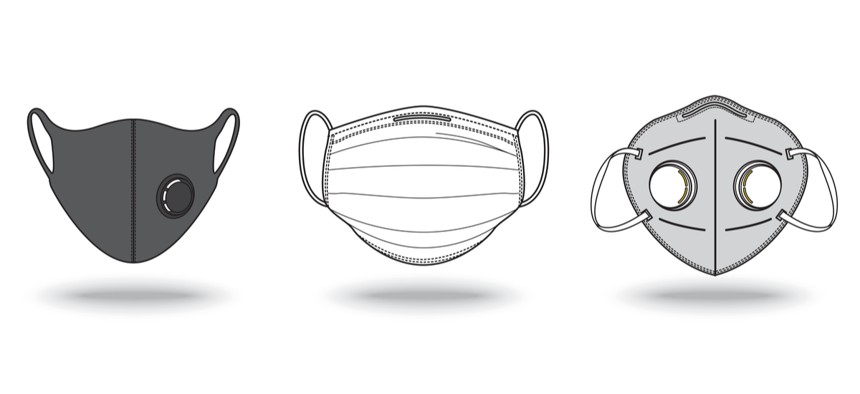Do All Face Masks Offer Similar Protection? New Test Offers A Way to Compare

AthinuntR/Shutterstock.com
The limited findings raise doubts about the effectiveness of neck gaiters and bandanas in preventing the spread of the coronavirus.
While public health experts say that face masks can greatly help to reduce the risk of the coronavirus spreading from person to person, all of the options that Americans have been using to cover their noses and mouths don’t necessarily provide equal levels of protection.
A new study from researchers at Duke University offers an inexpensive method for evaluating how well different kinds of masks work and offers hints as to which ones might be better at stopping the airborne respiratory droplets that can transmit the disease.
The study focuses on an issue—the effectiveness of different types of masks—that is significant for state and local policy makers who, in many cases, are recommending that people wear face coverings when in public places. Many states and local governments have imposed mask requirements, including in recent weeks public officials who had previously resisted these mandates.
If the initial—but very limited—findings from the study are any indication, coverings like bandanas may offer significantly less protection compared to other mask options, and neck gaiters could actually be worse than wearing no mask at all. Surgical masks, on the other hand, along with certain fabric masks made of polypropylene and cotton material, appeared to offer better protections.
But the authors of the study caution that their results for how well different types of masks perform are meant to serve only as a demonstration for how their method for testing can work, rather than providing comprehensive evidence for which masks are safest.
“Determining mask efficacy is a complex topic that is still an active field of research,” they write. And if any type of mask fits poorly or is worn incorrectly its effectiveness can be undermined.
The demonstration tests involved only a few people. One speaker used each type of mask and four speakers used a subset of the coverings, including surgical masks, bandanas and one type of cotton mask.
Even so, the researchers say, “important general characteristics” can be gleaned from their work about how different masks compare.
The basic idea with masks is that if a person is infected with the coronavirus, a covering on their nose and mouth will result in reduced spread of infected respiratory droplets in the air around them. This cuts down on the chances that they will infect other people nearby.
Because people don’t always have obvious symptoms of the virus, masks are seen as a potentially important safety measure most people can adopt with relatively little inconvenience.
The Centers for Disease Control and Prevention recommends that people wear masks when in public settings, and around others who don’t live in the same household. The agency offers instructions on how to make homemade masks using cloth.
Surgical masks and N-95 respirators are still considered critical supplies that should be reserved for healthcare workers and first responders, the CDC also says. Medical facilities in some places have run short on those types of masks during the course of the pandemic.
To conduct their tests, the Duke researchers had people put on different types of masks and then speak into a dark enclosure where they also shined a laser beam. A cell phone video camera was used to record the droplets of breath that show up in the light of the laser.
Later, the researchers were able to use computer software to count the droplets that appeared on the video for each type of mask they tested.
They say that this setup is relatively cheap, with the laser and other optical equipment required available for under $200.
In total, they tested 14 different types of face coverings, including three-layer surgical masks, two types of N-95 masks, and various cotton masks, along with bandanas and a fleece neck gaiter.
Based on the study’s limited findings, the masks that were best at stopping the transmission of particles included fitted N-95 masks without exhalation valves and surgical masks. Masks made from polypropylene, or polypropylene and cotton also performed well.
Most of the other masks, to varying degrees, also stopped respiratory particles that a person would otherwise spread while speaking if they were maskless, the tests found.
The bandana and fleece neck gaiter, though, were the worst performers. The bandana appeared to be somewhat better than going maskless, but was far less effective than options like a surgical mask, or some of the cotton or polypropylene designs.
The gaiter seemed to break up, or disperse, large droplets of breath, increasing the count of droplets in the air and resulting in smaller droplets that can stay airborne longer than larger ones.
Droplet transmission with the gaiter was actually 10 percentage points greater than wearing no mask, the researchers found. “The use of such a mask might be counterproductive,” they wrote.
There are limitations with the method used to test the masks, the authors of the study acknowledge. For instance, some droplets might not be showing up in the light of the laser beam, or the cell phone camera might not detect all of them.
The research article was published online on Aug. 7 by Science Advances. A copy of it can be found here.






